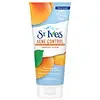What's inside
What's inside
 Key Ingredients
Key Ingredients

 Benefits
Benefits

 Concerns
Concerns

 Ingredients Side-by-side
Ingredients Side-by-side

Salicylic Acid
MaskingWater
Skin ConditioningJuglans Regia Shell Powder
AbrasiveGlyceryl Stearate Se
EmulsifyingGlycerin
HumectantCetearyl Alcohol
EmollientZea Mays Kernel Meal
AbrasiveCetyl Alcohol
EmollientTriethanolamine
BufferingSodium Lauryl Sulfoacetate
CleansingCocamidopropyl Betaine
CleansingGlyceryl Stearate
EmollientPEG-100 Stearate
Cetyl Acetate
EmollientBenzyl Alcohol
PerfumingCarbomer
Emulsion StabilisingCeteareth-20
CleansingAcetylated Lanolin Alcohol
EmollientPolysorbate 60
EmulsifyingParfum
MaskingDisodium EDTA
Benzoic Acid
MaskingSorbic Acid
PreservativePrunus Armeniaca Fruit Extract
Skin ConditioningCI 77891
Cosmetic ColorantSalicylic Acid, Water, Juglans Regia Shell Powder, Glyceryl Stearate Se, Glycerin, Cetearyl Alcohol, Zea Mays Kernel Meal, Cetyl Alcohol, Triethanolamine, Sodium Lauryl Sulfoacetate, Cocamidopropyl Betaine, Glyceryl Stearate, PEG-100 Stearate, Cetyl Acetate, Benzyl Alcohol, Carbomer, Ceteareth-20, Acetylated Lanolin Alcohol, Polysorbate 60, Parfum, Disodium EDTA, Benzoic Acid, Sorbic Acid, Prunus Armeniaca Fruit Extract, CI 77891
Salicylic Acid 2%
MaskingWater
Skin ConditioningSodium C14-16 Olefin Sulfonate
CleansingCocamidopropyl Betaine
CleansingSodium Chloride
MaskingPEG-120 Methyl Glucose Dioleate
EmulsifyingPolysorbate 20
EmulsifyingLinoleamidopropyl Pg-Dimonium Chloride Phosphate
Propylene Glycol
HumectantPEG-80 Sorbitan Laurate
Parfum
MaskingDisodium EDTA
Benzalkonium Chloride
AntimicrobialC12-15 Alkyl Lactate
EmollientPolyquaternium-7
Sodium Benzotriazolyl Butylphenol Sulfonate
UV AbsorberCocamidopropyl Pg-Dimonium Chloride Phosphate
Ascorbyl Palmitate
AntioxidantAloe Barbadensis Leaf Extract
EmollientAnthemis Nobilis Flower Extract
MaskingChamomilla Recutita Flower Extract
MaskingCitrus Grandis Fruit Extract
AstringentCitric Acid
BufferingSodium Hydroxide
BufferingCI 16035
Cosmetic ColorantCI 60725
Cosmetic ColorantSalicylic Acid 2%, Water, Sodium C14-16 Olefin Sulfonate, Cocamidopropyl Betaine, Sodium Chloride, PEG-120 Methyl Glucose Dioleate, Polysorbate 20, Linoleamidopropyl Pg-Dimonium Chloride Phosphate, Propylene Glycol, PEG-80 Sorbitan Laurate, Parfum, Disodium EDTA, Benzalkonium Chloride, C12-15 Alkyl Lactate, Polyquaternium-7, Sodium Benzotriazolyl Butylphenol Sulfonate, Cocamidopropyl Pg-Dimonium Chloride Phosphate, Ascorbyl Palmitate, Aloe Barbadensis Leaf Extract, Anthemis Nobilis Flower Extract, Chamomilla Recutita Flower Extract, Citrus Grandis Fruit Extract, Citric Acid, Sodium Hydroxide, CI 16035, CI 60725
 Reviews
Reviews

Ingredients Explained
These ingredients are found in both products.
Ingredients higher up in an ingredient list are typically present in a larger amount.
Cocamidopropyl Betaine is a fatty acid created by mixing similar compounds in coconut oil and dimethylaminopropylamine, a compound with two amino groups.
This ingredient is a surfactant and cleanser. It helps gather the dirt, pollutants, and other impurities in your skin to be washed away. It also helps thicken a product and make the texture more creamy.
Being created from coconut oil means Cocamidopropyl Betaine is hydrating for the skin.
While Cocamidopropyl Betaine was believed to be an allergen, a study from 2012 disproved this. It found two compounds in unpure Cocamidopropyl Betaine to be the irritants: aminoamide and 3-dimethylaminopropylamine. High-grade and pure Cocamidopropyl Betaine did not induce allergic reactions during this study.
Learn more about Cocamidopropyl BetaineDisodium EDTA plays a role in making products more stable by aiding other preservatives.
It is a chelating agent, meaning it neutralizes metal ions that may be found in a product.
Disodium EDTA is a salt of edetic acid and is found to be safe in cosmetic ingredients.
Learn more about Disodium EDTAParfum is a catch-all term for an ingredient or more that is used to give a scent to products.
Also called "fragrance", this ingredient can be a blend of hundreds of chemicals or plant oils. This means every product with "fragrance" or "parfum" in the ingredients list is a different mixture.
For instance, Habanolide is a proprietary trade name for a specific aroma chemical. When used as a fragrance ingredient in cosmetics, most aroma chemicals fall under the broad labeling category of “FRAGRANCE” or “PARFUM” according to EU and US regulations.
The term 'parfum' or 'fragrance' is not regulated in many countries. In many cases, it is up to the brand to define this term.
For instance, many brands choose to label themselves as "fragrance-free" because they are not using synthetic fragrances. However, their products may still contain ingredients such as essential oils that are considered a fragrance by INCI standards.
One example is Calendula flower extract. Calendula is an essential oil that still imparts a scent or 'fragrance'.
Depending on the blend, the ingredients in the mixture can cause allergies and sensitivities on the skin. Some ingredients that are known EU allergens include linalool and citronellol.
Parfum can also be used to mask or cover an unpleasant scent.
The bottom line is: not all fragrances/parfum/ingredients are created equally. If you are worried about fragrances, we recommend taking a closer look at an ingredient. And of course, we always recommend speaking with a professional.
Learn more about ParfumSalicylic Acid (also known as beta hydroxy acid or BHA) is a well-known ingredient for treating skin that struggles with acne and clogged pores. It exfoliates both the skin's surface and deep within the pores to help clear out buildup, control oil, and reduce inflammation.
Unlike AHAs (alpha hydroxy acids), salicylic acid is oil-soluble. This allows it to penetrate into pores which makes it especially effective for treating blackheads and preventing future breakouts.
Salicylic acid is also known for its soothing properties. It has a similar structure to aspirin and can calm inflamed or irritated skin, making it a good option for acne-prone skin that is also sensitive.
Concentrations of 0.5-2% are recognized by the U.S. FDA as an over-the-counter topical acne product.
It can cause irritation and/or dryness if one's skin already has a compromised moisture barrier, so it's best to focus on repairing that before introducing this ingredient into your routine.
While salicylic acid does not increase sun sensitivity, it’s still important to wear sunscreen daily to protect your skin.
If you are looking for the ingredient called BHA or Butylated Hydroxyanisole, click here.
Learn more about Salicylic AcidWater. It's the most common cosmetic ingredient of all. You'll usually see it at the top of ingredient lists, meaning that it makes up the largest part of the product.
So why is it so popular? Water most often acts as a solvent - this means that it helps dissolve other ingredients into the formulation.
You'll also recognize water as that liquid we all need to stay alive. If you see this, drink a glass of water. Stay hydrated!
Learn more about Water